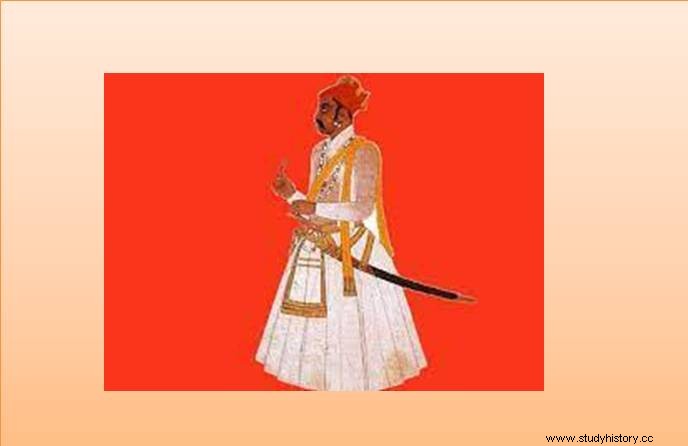
Aurangzeb died on 21 February 1707. After his death, according to the tradition of the Mughals, a bloody struggle broke out among all the sons of the emperor for the Mughal throne. One of them had to win and the rest had to die. At the time of Aurangzeb's death, his youngest son was Kambakhsh Dakshin. He remained silently sitting in the south because his idea was to create an independent state for himself in South India itself. Thus a fierce battle was fought between Aurangzeb's eldest son Muazzam and his younger son Azam. Prince Azam was at this time in the south and was posted in Gujarat with Bedar Bakht, son of Jai Singh Azam. Therefore, Jai Singh was compelled to support Azam and Bedar Bakht. Raja Jai Singh's younger brother Vijay Singh, who wanted to become the ruler of Amer, supported Muazzam in this struggle. Vijay Singh was also called Cheemaji. A decisive battle was fought between the armies of Muazzam and Azam in the field of Jajau. Within a few hours of the start of the war, it became clear that Muazzam's army was getting heavy. So Raja Jai Singh, renouncing Azam's side, joined Muazzam along with a thousand of his soldiers. The war resulted in the death of Azam and Azam's son Bedar Bakht. In June 1707, the 65-year-old and jealous Muazzam ascended the throne of the Mughals by the name of Bahadur Shah. Like Aurangzeb, he too became hostile to Jaisingh because Jai Singh had supported Azam in the beginning.
Jaisingh's resignation
As soon as he became the emperor, Bahadur Shah came to Amber to punish Sawai Jai Singh. He offered Namaz in the mosque built by Akbar in Amer and named Amer as Mominabad. Bahadur Shah was two yards ahead of his father Aurangzeb in cunning and cunning. He snatched the kingdom of Amber from Jai Singh on 10 January 1708 and made his younger brother Vijay Singh the king and gave him the title of Mirza Raja. Only the Jagir of Dausa was left with Jai Singh. Due to his abdication, Jai Singh now remained a mere Mughal mansabdar. Bahadur Shah then moved south to deal with his younger brother Kambakhsh as Kambakhsh had declared himself the emperor of Hyderabad. Sawai Jai Singh also went south with Bahadur Shah in the hope of regaining the kingdom of Amber. He believed that as soon as Bahadur Shah's anger subsided, he would get the kingdom of Amer back. On the way, Jodhpur's deposed successor Ajit Singh also joined Jai Singh. In Merta, both the kings met Bahadur Shah and prayed to return the kingdom of Amer to Sawai Jai Singh, which the emperor refused.
United Front of Mewar, Marwar and Amer
Jai Singh and Ajit Singh continued to accompany Bahadur Shah till Mandleshwar, but when they did not get any assurance from the emperor, on 21 April 1708, both the kings quietly left Mandleshwar and went to Udaipur near Maharana Amar Singh (II) of Mewar. Reached. When Bahadur Shah came to know about this, he wrote to Maharana that if both the kings appeared in the royal court and apologized, then their kingdoms would be returned to them again, but the three Rajput kings decided to compete with the Mughals. Raja Jai Singh resolved not to send the dolls of Kachhwaha princesses to the Mughals. The combined armies of the three kings first reached Jodhpur and in July 1708, Ajit Singh got the right of Jodhpur. After this these combined forces moved towards Amber. Vijay Singh and the Mughal Faujdar were defeated and expelled from Amber and Sawai Jai Singh was again placed on the throne of Amer. The Mughal Subedar of Mewat plundered the state of Amber for a few days, but Jai Singh soon drove him out of the state of Amber.
When the rulers of Mewar, Marwar and Amer had planned to fight the Mughals jointly, on that occasion, the Maharana of Mewar married his daughter Chandrakunwari with Jai Singh to strengthen mutual relations. Some conditions were also fixed at the time of this marriage – the princess of Udaipur, however small, would be considered the chief among all the queens. The son of Chandra Kunwari will be considered as the crown prince. If a girl is born from a moon virgin, then she will not be married to Muslims. By accepting these conditions, Jai Singh laid the foundation for the future civil war. After regaining power over Jodhpur, Ajit Singh also married his daughter Suraj Kunwari to Jai Singh. After this, there was mutual unity among these states for some time. In October 1708, Syed Hussain Baraha and Chudaman Jats marched on Amber with their armies. Both their armies were beaten and driven out.
Attempt by Bahadur Shah
When Bahadur Shah returned to North India after dealing with Kambakhsh, he got news of the Sikh rebellion. Bahadur Shah realized that it was impossible to suppress the Sikhs without the help of the Rajputs. So he accepted Sawai Jai Singh as the ruler of Amer, but Jai Singh was not satisfied with this. He wanted a suitable mansab for himself and an important position in the Mughal Sultanate. Bahadur Shah died in 1712 AD.
Jahandar Shah and Sawai Jai Singh
Jahandar Shah (1712-13 AD), the successor of Bahadur Shah, continued to try to persuade Jai Singh. Therefore, during this time there was peace in the life of Jai Singh and in the kingdom of Jai Singh.
